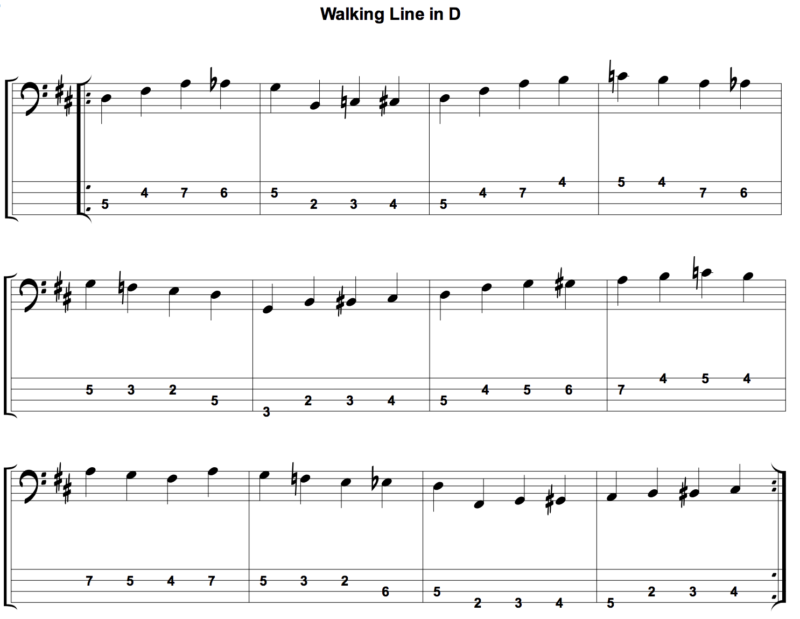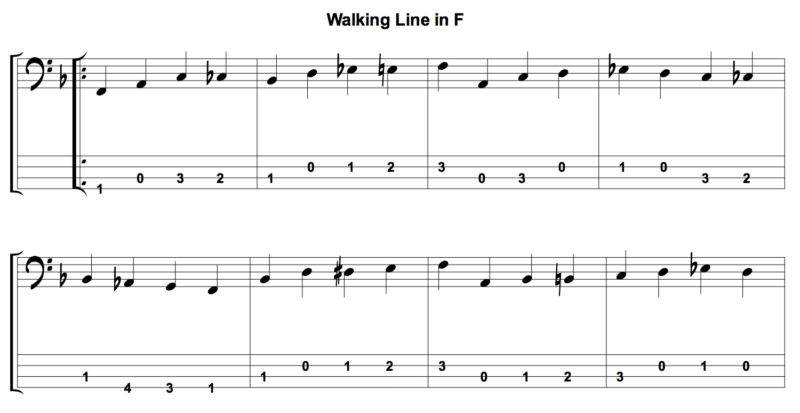In this lesson we’re going to expand on last week’s walking line by transposing it to a variety of different keys
Recap
This lesson is a follow up to the previous that worked through a simple walking bass line over a basic jazz blues progression. First of all, let’s look at the sequence and line:

This sequence is a basic quick change jazz blues progression – if you have any problems understanding or memorising this then check out the lesson on it here.
Transposing
Being able to play a walking bass line is no good if you can only do it in one key. The trick to playing in any key is to transpose loads of bass lines and get used to picking them up and moving them to different places.
We are going to take the line above and transpose it to the key of D, like this:

If you remember from the last lesson, we split the line up into smaller fragments that were easier to memorise. We are going to do this again so that we can concentrate on one piece at a time. If you were dealing with a very short bass line, maybe one or two bars long, then it would be easier to take the whole thing to a new key in one move. Walking bass lines are much longer and tougher to understand in one go so it makes sense to do it in smaller steps.
There are two ways you can transpose a section of a bass line – you can either memorise the pattern and move it to another fret, or you can number the notes in relation to the major scale. This enables you to move the numbers to the new key and work the notes out from there. The number method is slightly longer and trickier but it will really help improve your theory and make it easier to transpose in the future.
Our first fragment is bar 1 and we are moving from C7 to F7 – chord I to chord IV. Let’s look at the notes used in the bass line and number them accordingly.
C D E F G A B – C Major scale
1 2 3 4 5 6 7
C E G Gb – Notes in bar 1
1 3 5 b5
We can assign these numbers to any key that we want, as we want to move to D, we will use the D major scale.
D E F# G A B C# – D Major scale
1 2 3 4 5 6 7
D F# A Ab – Notes in bar 1
1 3 5 b5
Another advantage of breaking walking bass lines into small fragments like this is that you can memorise them for use in your own playing. The section we just looked at gave us a way of getting from chord I to chord IV, so if you can remember this phrase and be able to play it in any key then you will be able to use it whenever you see this change.
Try to work the rest of the bass line out in the key of D without looking at the notation. This will get it in your head much quicker and breaking it down will give you a better idea of what is going on musically. Once you feel comfortable in the new key, change again! There is an example below in the key of F but you can choose any key you want.















Once again Mark doing what no one else on the internet and making it easy!
great lesson and helpful for learning all keys, fretboard knowledge, chord tones and rythm all in one..
Heard Scott give you a shout out earlier on SBL Live 2016. that made me smile. our Mark!
Hi Mark,
Thank you very much for your recent walking bass lessons 136 and 137, in addition to the previous walking bass and blues lessons. Please keep the walking and blues lessons coming !!
Thank you for all your lessons. They are fantastic !!!
Hi Mark,
To me, the best bass teacher on the internet!
Thank you